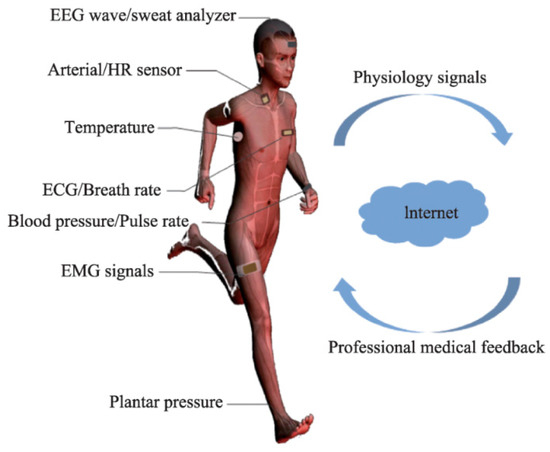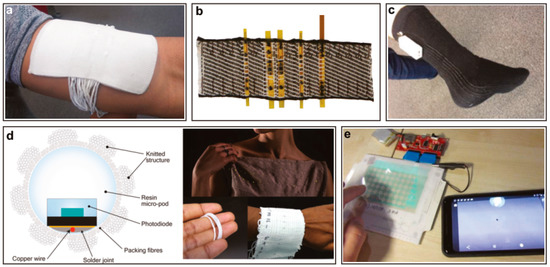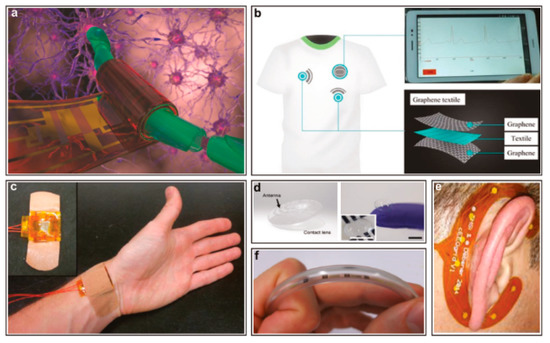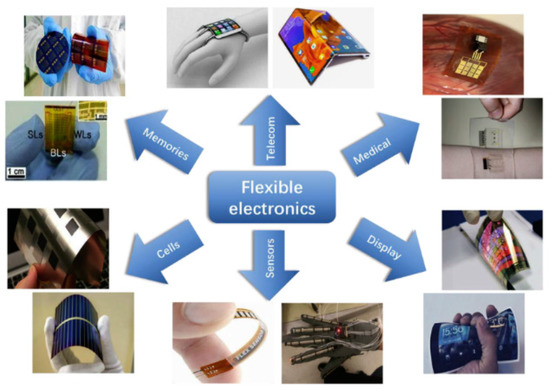Flexible electronics is a rapidly growing technology for a multitude of applications. Wearables and flexible displays are some application examples.
- flexible electronics
- flexible substrates
- applications of flexible electronics
1. Introduction
The market for flexible electronics is growing steadily [1,2,3][1][2][3]. Reasons for the growing numbers of flexible electronics used include mechanical flexibility, high scalability, low weight, and, last but not least, large-area production compatibility [4,5,6][4][5][6]. Because of these advantages, flexible electronics find more applications and use in the industry in many sectors [6]. It is estimated that the global market for flexible electronics will be around 87.21 billion USD in 2024. In the Asia Pacific region alone, the market is expected to grow from about 5 billion USD in 2013 to 30 billion USD in 2024 [7]. Furthermore, according to a study by IDTechEx, the global demand for flexible hybrid electronics will reach a value of over $3 billion in 2030 [8]. Applications of flexible electronics include consumer electronics [9[9][10],10], industry technology [11[11][12][13][14],12,13,14], healthcare [15[15][16][17],16,17], automotive technology [4[4][18],18], and aerospace technology [18][19] [18,19] (Figure 1). These sectors drive the growth of the market for flexible electronics. Related to flexible electronics, there is also a trend to foldable and stretchable electronic systems, which can be used in applications such as wearable and implantable electronics in healthcare, displays in consumer electronics, and robotic skin in industry applications [20].
Established semiconductor technologies can be integrated into flexible electronics, so that this combination has the ability to be bendable, deformed into irregular shapes, or even stretched [15,21][15][21]. Flexible electronics consist of electronic components, such as surface-mounted devices (SMDs) or ultra-thin chips on flexible substrates [22,23][22][23]. The electronic components are not flexible by nature but are as thin as possible to provide flexibility as a complete system when integrating onto or in flexible substrates [23,24][23][24]. Bending strain is one of the main movements inducing cracks and leading to the malfunction of flexible structures [20]. The mechanical reliability of these flexible electronics is very important to ensure the growing market demand for those systems. Furthermore, the robustness of the components and their integration should be optimized [25,26][25][26]. Ultra-thin chips are very common in flexible electronics and therefore need to be strong enough to withstand the tension that occurs during production and handling [12]. The integration of these ultra-thin and bendable integrated circuits in roll-to-roll processes enables the development of cheap, mechanically flexible electronics. To make these systems reliable, detailed investigations of both the strength and the deformation of the layers of thin components have to be performed. Once these properties are known, individual technology steps can be characterized and optimized in the best possible way [27].
Flexible electronics must be able to deform and at the same time, both the functional properties and the electronic parameters must remain unaffected by bending during application [19]. Moreover, with growing demands on the reliability of flexible systems, the need for characterization of the mechanical stability of the components also increases. [28]. Therefore, the testing of their reliability under mechanical bending is essential [29,30][29][30]. The goals of the bending test are to understand the behavior of flexible systems under bending and their fatigue stability.
The failures associated with bending strongly influence the reliability of the components. This failure is mainly caused by the forces generated due to bending or vibration of the circuit carriers [31].
2. Substrates for Flexible Electronics
Flexible systems require mechanically compliant substrates that adapt to soft and irregularly shaped surfaces. Furthermore, large area compatibility, chemical stability, process-compatible melting and glass transition temperatures, outgassing rates as well as low surface roughness are very desirable properties for flexible systems [19,32][19][32]. Table 1 gives an overview of the most used substrates in flexible electronics and some useful properties.
Table 1. Overview of the most used plastic substrates for flexible electronics and some of their properties.
| Material | Polyethylene Naphthalate (PEN) |
Polyethylene Terephthalate (PET) |
Liquid-Crystal Polymer (LCP) |
Polydimethyl-Siloxane (PDMS) | Polyimide (PI) | |||||||
|---|---|---|---|---|---|---|---|---|---|---|---|---|
| Density (g/cm | 3 | ) | 1.39 [33] | 1.39 | 1.41 [33] | 1.41 | 1.38–1.95 [34] | 1.38–1.95 | 0.95–1.08 [34] | 0.95–1.08 | 1.06–1.45 [34] | 1.06–1.45 |
| Young’s modulus (MPa) | 2000 [33] | 2000 | 1700 [33] | 1700 | 5000–20,000 [34] | 5000–20,000 | 0.36–0.87 [34] | 0.36–0.87 | 1800–15,000 [34] | 1800–15,000 | ||
| Poisson ratio | 0.3–0.4 [2] | 0.3–0.4 | 0.3–0.4 [2] | 0.3–0.4 | 0.4 [35] | 0.4 | 0.5 [2] | 0.5 | 0.34 [2,36,37] | 0.34 | ||
| Glass transmission temperature (°C) | 116–120 [33] | 116–120 | 68–114 [33] | 68–114 | 82–280 [34] | 82–280 | −125 [34] | −125 | 290–430 [34] | 290–430 | ||
| Coefficient of thermal expansion (CTE) at 20 °C (ppm/K) | 10–14 [2] | 10–14 | 40–50 [2] | 40–50 | 4–38 [34] | 4–38 | 180–450 [34] | 180–450 | 3–50 [34,36] | 3–50 | ||
| Moisture absorption (%) | 0.3 [38] | 0.3 | 0.4 [38] | 0.4 | 0.02–0.04 [34] | 0.02–0.04 | 0.1–1.3 [34] | 0.1–1.3 | 2–4 [34] | 2–4 | ||
| Challenges | Lower thermal stability [26] | Lower thermal stability | Lower thermal stability [26] | Lower thermal stability | Lack of self-adhesion to metal [12,34] | Lack of self-adhesion to metal | High gas permeability [34,39] | High gas permeability | High moisture-uptake, short of rigidity [34,40] | High moisture-uptake, short of rigidity |
3. Application of Flexible Electronics
3.1. Wearables and E-Textiles
Flexible electronics are increasingly used in wearables and smart medical applications. Medical resources are reaching their limits when it comes to providing for our ageing society. Traditional medical methods cannot meet the needs of patients in time. Flexible and portable health monitoring, on the other hand, offers a completely new technology and alternative to traditional diagnostic methods. At the same time, health care will be portable and timely [41]. Figure 2 illustrates some physiological signals, which can be measured using wearable flexible sensors and then remotely evaluated.

Figure 2. Monitoring of some physiological signals using flexible sensors and diagnosis and evaluation per remote medicine. Adapted from [41]. The abbreviations EEG, HR, ECG, and EMG stand for electroencephalogram, heart rate, electrocardiogram, and electromyogram, respectively.
Someya et al. [9] [9] developed an electronic artificial skin based on large-area flexible pressure sensors with field-effect transistors built on a flexible substrate. Lumelsky et al. [42] [42] worked on a large-area, flexible array of sensors, consisting of LEDs and detectors, which can cover the entire surface of the human body or a machine and has the ability to detect many signals such as pressure, temperature, or even touch. Similar to Lumelsky, Manssfeld et al. [43] [43] published a paper on an electronic system using large arrays of capacitive pressure sensors with excellent sensitivity and very short response times on a flexible and stretchable polydimethylsiloxane (PDMS) substrate.
Compared to polymer foils, textile structures have additional potential for being stretched and deformed, while also allowing for a degree of breathability. For this reason, they can adapt well to the shape of the body. By integrating flexible sensors in textiles, namely, e-textiles, numerous applications can be realized, especially in the healthcare sector [32]. A market study by IDTechEx has predicted that the market for e-textiles will be worth over $1.4 billion by 2030 [44].
Figure 3 shows some examples of integrated flexible sensors in textiles and yarns. With the help of these sensors, vital parameters of the human body can be measured and further evaluated remotely.

Figure 3. Examples for smart textiles and their applications [32]. (a) Temperature sensing yarns in a textile for health monitoring [45]. (b) Optoelectronic near-infrared spectroscopy smart textile for measuring the blood oxygenation levels in health care [46]. (c) A temperature-sensing sock for fitness and health care [47]. (d) Embedded photodiodes in textile for health-monitoring [48]. (e) Tactile-sensing fabric for applications in human-machine interfaces (HMIs), smartphones, and Internet of Things (IoT) devices [49].
An et al. [50] [50] reported on the fabrication and characterization of a transparent and flexible fingerprint sensor array with multiplexed detection of tactile pressure and skin temperature for mobile devices and smartwatches. The sensor is built based on a silver nanofiber and fine silver nanowires (AgNWs) on a flexible polyimide substrate [50].
3.2. Flexible Displays
Optimization of organic light-emitting diodes (OLEDs) leads towards mechanical flexible displays when integrated on plastics. This is possible due to the unique properties of OLEDs, including their ultra-thin and simple structure and low-temperature manufacturing process [51]. Forrest [52] [52] reviewed the organic semiconductors used to fabricate flexible displays. Moreover, he covered the technologies for the deposition of polymer thin films. To reduce costs in the production of large-area flexible displays, Gelinck et al. [53] [53] demonstrated the use of organic transistors on flexible substrates for the development of flexible active-matrix monochrome electrophoretic displays. Figure 4 demonstrates the possible handling of flexible displays.
Im et al. [55] [55] reported on a process chain for fabricating a mechanically flexible OLED on flexible plastic substrate. A high performance conductive film with an embedded transparent conductive electrode of copper nanowires was used [55]. An attractive application for flexible displays is their integration into clothing and textiles. Ivanov et al. [56] [56] have investigated the use of light-emitting diodes (LEDs) and printed electroluminescent elements to fabricate flexible displays for integration into textiles. Huang et al. [57] [57] also reported on the integration of flexible displays into textiles.
3.3. Diagnostics and Healthcare
Flexible electronics gain more interest in medical sectors because they offer more comfort, while being in contact with patients [58]. In the early 2000s, Nathan et al. [59] [59] already reported on the use of large-area flexible electronics for large area X-ray imaging. They produced thin-film electronics on flexible polymer substrates. Both Jin et al. [60] [60] and Ko et al. [61] [61] published papers on the fabrication of electronic eye cameras on flexible polymer substrates. Figure 5 shows some applications for flexible electronics in the healthcare sector.

Figure 5. Applications for bio-monitoring, diagnosis, and hazards prevention [9]. (a) Flexible electronics for regenerative neuronal cuff implants [62]. (b) Flexible graphene wearable electrodes for dynamic ECG sensing [63]. (c) Flexible polymer transistors for application in electronic skin and health monitoring [64]. (d) Contact lens with ocular diagnostics of detecting the glucose levels in tears in diabetes patients [65]. (e) Ambulatory and wearable EEG sensor around the ear [66]. (f) Electronic nose on a flexible substrate for detecting hazardous gases [67].
An interesting approach for health monitoring and, for example, the realization of an e-skin, is the fabrication of active-matrix pressure sensors. These consist of integrated arrays of graphene transistors and can measure pressure up to higher-pressure ranges up to 3 MPa [68]. Other new research in medicine and electronics is the use of virtual reality (VR). Li et al. [41] [41] provided an overview of the use of flexible sensors for health monitoring in virtual reality. This trend in the use of flexible sensors is revolutionizing medicine and especially telemedicine. Flexible sensors can be applied to the skin, enabling personalized medicine by collecting important parameter data from the human body, and capturing meaningful changes in health status [69]. Gao et al. [69], Khan et al. [70], and Wang et al. [71] [71] reviewed the current researches and applications of flexible sensors to measure the vital signs of the human body.
References
- Bedjaoui, M.; Martin, S.; Salot, R. Interconnection of Flexible Lithium Thin Film Batteries for Systems-in-Foil. Proc. Electron. Compon. Technol. Conf. 2016, 2016–Augus, 2082–2088.
- Logothetidis, S. Handbook of Flexible Organic Electronics; Woodhead Puplishing, Elsevier: Amesterdam , The Netherlands, 2015; ISBN 9781782420354.
- Gupta, S.; Navaraj, W.T.; Lorenzelli, L.; Dahiya, R. Ultra-thin chips for high-performance flexible electronics. npj Flex. Electron. 2018, 2, 8.
- Nathan, B.A.; Ieee, F.; Ahnood, A.; Cole, M.T.; Lee, S.; Ieee, M.; Suzuki, Y.; Hiralal, P.; Bonaccorso, F.; Hasan, T.; et al. Flexible Electronics: The Next Ubiquitous Platform. Proc. IEEE 2012, 100, 1486–1517, doi:10.1109/jproc.2012.2190168.
- Tong, G.; Jia, Z.; Chang, J. Flexible Hybrid Electronics: Review and Challenges. Proc. IEEE Int. Symp. Circuits Syst. 2018, 2018–May, 1–5.
- Li, H.U.; Jackson, T.N. Flexibility testing strategies and apparatus for flexible electronics. IEEE Trans. Electron Devices 2016, 63, 1934–1939.
- GrandViewResearch. Flexible Electronics Market by Components (Display, Battery, Sensors, Memory), by Application (Consumer Electronics, Automotive, Healthcare, Industrial) And Segment Forecast to 2024. 2016. Available online: https://www.grandviewresearch.com/industry-analysis/flexible-electronics-market (accessed on 30 April 2020).
- Dyson, M.; Ghaffarzadeh, K. Flexible Hybrid Electronics 2020–2030: Applications, Challenges, Innovations and Forecasts; IDTechEx: Cambridge, UK, 2020.
- Someya, T.; Sekitani, T.; Iba, S.; Kato, Y.; Kawaguchi, H.; Sakurai, T. A large-area, flexible pressure sensor matrix with organic field-effect transistors for artificial skin applications. Proc. Natl. Acad. Sci. USA 2004, 101, 9966–9970.
- Kim, J.H.; Lee, T.I.; Shin, J.W.; Kim, T.S.; Paik, K.W. Bending Properties of Anisotropic Conductive Films Assembled Chip-in-Flex Packages for Wearable Electronics Applications. IEEE Trans. Compon. Packag. Manuf. Technol. 2016, 6, 208–215.
- Gao, W.; Zhu, Y.; Wang, Y.; Yuan, G.; Liu, J.M. A review of flexible perovskite oxide ferroelectric films and their application. J. Mater. 2020, 6, 1–16.
- Kröninger, W.J.; Ossowski, L. Successful processing of thinned silicon chips thresholds and limits in mechanical properties. In Proceedings of the 2004 IEEE/SEMI Advanced Semiconductor Manufacturing Conference and Workshop (IEEE Cat. No. 04CH37530), Boston, MA, USA, 4–6 May 2004; pp. 232–236.
- Van Den Ende, D.A.; Van De Wiel, H.J.; Kusters, R.H.L.; Sridhar, A.; Schram, J.F.M.; Cauwe, M.; Van Den Brand, J. Mechanical and electrical properties of ultra-thin chips and flexible electronics assemblies during bending. Microelectron. Reliab. 2014, 54, 2860–2870.
- Harendt, C.; Kostelnik, J.; Kugler, A.; Lorenz, E.; Saller, S.; Schreivogel, A.; Yu, Z.; Burghartz, J.N. Hybrid Systems in Foil (HySiF) exploiting ultra-thin flexible chips. Solid State Electron. 2015, 113, 101–108.
- Rogers, J.A.; Someya, T.; Huang, Y. Materials and mechanics for stretchable electronics. Science (80-) 2010, 327, 1603–1607.
- Kunkel, G.; Debski, T.; Burkard, H.; Link, J.; Petersen, A.E.; Christiaens, W.; Vanfleteren, J. Ultra-flexible and ultra-thin embedded medical devices on large area panels. Electron. Syst. Integr. Technol. Conf. ESTC 2010 Proc. 2010, doi:10.1109/estc.2010.5642850.
- Servati, A.; Zou, L.; Jane Wang, Z.; Ko, F.; Servati, P. Novel flexible wearable sensor materials and signal processing for vital sign and human activity monitoring. Sensors 2017, 17, 1622.
- Loher, T.; Seckel, M.; Pahl, B.; Böttcher, L.; Ostmann, A.; Reichl, H. Highly integrated flexible electronic circuits and modules. In Proceedings of the 2008 3rd International Microsystems, Packagaging, Assembly and Circuits Technology Conference, IMPACT 2008, Tabie, Taiwen, 22–24 October 2008; pp. 86–89.
- Harris, K.D.; Elias, A.L.; Chung, H.J. Flexible electronics under strain: A review of mechanical characterization and durability enhancement strategies. J. Mater. Sci. 2016, 51, 2771–2805.
- Dahiya, R.S.; Gennaro, S. Bendable ultra-thin chips on flexible foils. IEEE Sens. J. 2013, 13, 4030–4037.
- Su, Y.; Liu, Z.; Kim, S.; Wu, J.; Huang, Y.; Rogers, J.A. Mechanics of stretchable electronics with high fill factors. Int. J. Solids Struct. 2012, 49, 3416–3421.
- Hamasha, M.M.; Alzoubi, K.; Switzer, J.C.; Lu, S.; Poliks, M.D.; Westgate, C.R. Reliability of sputtered aluminum thin film on flexible substrate under high cyclic bending fatigue conditions. IEEE Trans. Compon. Packag. Manuf. Technol. 2012, 2, 2007–2016.
- Janek, F.; Saller, E.; Müller, E.; Meißner, T.; Weser, S.; Barth, M.; Eberhardt, W.; Zimmermann, A. Feasibility study of an automated assembly process for ultrathin chips. Micromachines 2020, 11, 654.
- Akinwande, D., Petrone, N. & Hone, J. Two-dimensional flexible nanoelectronics. Nat Commun 5, 5678 (2014). https://doi.org/10.1038/ncomms6678.
- Palavesam, N.; Landesberger, C.; Kutter, C.; Bock, K. Finite element analysis of uniaxial bending of ultra-thin silicon dies embedded in flexible foil substrates. In Proceedings of the 2015 11th Conference on Ph.D. Research Microelectronics and Electronics (PRIME 2015), Glasgow, UK, 29 June–2 July 2015; pp. 137–140.
- Burghartz, J.N. Ultra-Thin Chip Technology and Applications; Burghartz, J., Ed.; Springer: New York, NY, USA, 2011; Volume 53; ISBN 978-1-4419-7275-0.
- Schoenfelder, S.; Ebert, M.; Landesberger, C.; Bock, K.; Bagdahn, J. Investigations of the influence of dicing techniques on the strength properties of thin silicon. Microelectron. Reliab. 2007, 47, 168–178.
- Endler, S.; Angelopoulos, E.A.; Harendt, C.; Hoang, T.; Rempp, H.; Burghartz, J.N. Bestimmung der mechanischen Stabilität ultradünner Chips. In Mikrosystemtechnik Kongress 2011; VDE Verlag GmbH: Berling, Germany, 2011; pp. 737–740.
- Palavesam, N.; Landesberger, C.; Bock, K. Investigations of the fracture strength of thin silicon dies embedded in flexible foil substrates. In Proceedings of the 2014 IEEE 20th International Symposium for Design and Technology in Electronic Packaging (SIITME), Bucharest, Romania, 23–26 October 2014; pp. 267–271.
- Endler, S.; Hoang, T.; Angelopoulos, E.A.; Rempp, H.; Harendt, C.; Burghart, J.N. Mechanical characterisation of ultra-thin chips. In Proceedings of the IEEE—2011 Semiconductor Conference Dresden: Technology, Design, Packaging, Simulation and Test, SCD 2011—International Conference, Workshop and Table-Top Exhibition, Dresden, Germany, 27–28 September 2011; pp. 3–6.
- Al Ahmar, J.; Wiss, E.; Wiese, S. Four-point-bending experiments on multilayer ceramic capacitors: Microstructural details on crack initiation and propagation. In Proceedings of the 2018 19th International Conference on Thermal, Mechanical and Multi-Physics Simulation and Experiments in Microelectronics and Microsystems (EuroSimE), Toulouse, France, 15–18 April 2018; pp. 1–6.
- Costa, J.C.; Spina, F.; Lugoda, P.; Garcia-Garcia, L.; Roggen, D.; Münzenrieder, N. Flexible Sensors—From Materials to Applications. Technologies 2019, 7, 35.
- Mark, J.E. Polymer Data Handbook; Mark, J.E., Ed.; Oxford University Press: Oxford, UK, 1999; ISBN 9780195107890.
- Qin, Y.; Howlader, M.M.R.; Deen, M.J.; Haddara, Y.M.; Selvaganapathy, P.R. Polymer integration for packaging of implantable sensors. Sens. Actuators B Chem. 2014, 202, 758–778.
- Rizvi, M.J.; Yin, C.Y.; Bailey, C. Modeling the effect of lead-free soldering on flexible substrates. In Proceedings of the 2006 International Conference on Electronic Materials and Packaging, Kowloon, China, 11–14 December 2006.
- Alavi, G.; Hassan, M.; Harendt, C.; Burghartz, J.N. Compensation of Stress-Induced Warpage for Polymer Embedding of Ultra-thin Chips Compensation of Stress–Induced Warpage for Polymer Embedding of Ultra–Thin Chips. Conference paper in Proceedings of the ICT.OPEN 2015, Amersfoort, Netherlands,2015.
- Sivapurapu, S.; Chen, R.; Mehta, C.; Zhou, Y.; Bellaredj, M.L.F.; Jia, X.; Kohl, P.; Huang, T.-C.; Sitaraman, S.K.; Swaminathan, M. Multi-physics Modeling & Characterization of Components on Flexible Substrates. IEEE Trans. Compon. Packag. Manuf. Technol. 2019, 9, 1.
- Palavesam, N.; Marin, S.; Hemmetzberger, D.; Landesberger, C.; Bock, K.; Kutter, C. Roll-to-roll processing of film substrates for hybrid integrated flexible electronics. Flex. Print. Electron. 2018, 3, 014002.
- Lötters, J.; Olthuis, W.; Veltink, P.; Bergveld, P. The mechanical properties of the rubber elastic polymer polydimethylsiloxane for sensor applications. J. Micromechanics Microengineering, vol. 7, no. 3, pp. 145–147, 1997.
- Stieglitz, T.; Beutel, H.; Schuettler, M.; Meyer, J. Micromachined, polyimide-based devices for flexible neural interfaces. Biomed. Microdevices, vol. 2, no. 4, pp. 283–294, 2000.
- Li, Y.; Zheng, L.; Wang, X. Flexible and wearable healthcare sensors for visual reality health-monitoring. Virtual Real. Intell. Hardw. 2019, 1, 411–427.
- Lumelsky, V.J.; Shur, M.S.; Wagner, S. Sensitive skin. IEEE Sens. J. 2001, 1, 41–51.
- Mannsfeld, S.C.B.; Tee, B.C.-K.; Stoltenberg, R.M.; Chen, C.V.H.-H.; Barman, S.; Muir, B.V.O.; Sokolov, A.N.; Reese, C.; Bao, Z. Highly sensitive flexible pressure sensors with microstructured rubber dielectric layers. Nat. Mater. 2010, 9, 859–864.
- Hayward, J. E-Textiles and Smart Clothing 2020–2030: Technologies, Markets and Players; IDTechEx: Cambridge, UK, 2020.
- Lugoda, P.; Hughes-Riley, T.; Morris, R.; Dias, T. A Wearable Textile Thermograph. Sensors 2018, 18, 2369.
- Zysset, C.; Nasseri, N.; Büthe, L.; Münzenrieder, N.; Kinkeldei, T.; Petti, L.; Kleiser, S.; Salvatore, G.A.; Wolf, M.; Tröster, G. Textile integrated sensors and actuators for near-infrared spectroscopy. Opt. Express 2013, 21, 3213.
- Hughes-Riley, T.; Lugoda, P.; Dias, T.; Trabi, C.; Morris, R. A Study of Thermistor Performance within a Textile Structure. Sensors 2017, 17, 1804.
- Satharasinghe, A.; Hughes-Riley, T.; Dias, T. Photodiodes embedded within electronic textiles. Sci. Rep. 2018, 8, 16205.
- Ferri, J.; Perez Fuster, C.; Llinares Llopis, R.; Moreno, J.; Garcia‑Breijo, E. Integration of a 2D Touch Sensor with an Electroluminescent Display by Using a Screen-Printing Technology on Textile Substrate. Sensors 2018, 18, 3313.
- An, B.W.; Heo, S.; Ji, S.; Bien, F.; Park, J.U. Transparent and flexible fingerprint sensor array with multiplexed detection of tactile pressure and skin temperature. Nat. Commun. 2018, 9, 2458.
- Lee, S.M.; Kwon, J.H.; Kwon, S.; Choi, K.C. A Review of Flexible OLEDs Toward Highly Durable Unusual Displays. IEEE Trans. Electron Devices 2017, 64, 1922–1931.
- Forrest, S.R. The path to ubiquitous and low-cost organic electronic appliances on plastic. Nature 2004, 428, 911–918.
- Gelinck, G.H.; Huitema, H.E.A.; Van Veenendaal, E.; Cantatore, E.; Schrijnemakers, L.; Van Der Putten, J.B.P.H.; Geuns, T.C.T.; Beenhakkers, M.; Giesbers, J.B.; Huisman, B.H.; et al. Flexible active-matrix displays and shift registers based on solution-processed organic transistors. Nat. Mater. 2004, 3, 106–110.
- Nagaraju, S. Shapers: Capturing free form shapes for bendable device interactions. Procedia Comput. Sci. 2014, 39, 158–161.
- Im, H.G.; Jung, S.H.; Jin, J.; Lee, D.; Lee, J.; Lee, D.; Lee, J.Y.; Kim, I.D.; Bae, B.S. Flexible transparent conducting hybrid film using a surface-embedded copper nanowire network: A highly oxidation-resistant copper nanowire electrode for flexible optoelectronics. ACS Nano 2014, 8, 10973–10979.
- Ivanov, A. Implementation of Flexible Displays for Smart Textiles Using Processes of Printed Electronics. In Proceedings of the 2019 IMAPS Nordic Conference Microelectronics Packaging (NordPac), Copenhagen, Denmark, 11-13 June 2019; pp. 21–28.
- Huang, W.H.S.; Wang, Y.C.; Hsu, P.C.; Wang, W.C.; Cavalier, A.; Huang, T.H.; Shen, C.L. Flexible LED Displays for Electronic Textiles. 2018 Int. Flex. Electron. Technol. Conf. IFETC 2018 2018, 2, 4–6.
- Lin, J.; Yan, B.; Wu, X.; Ren, T.; Liu, L. Stretchable interconnections for flexible electronic systems. In Proceedings of the 31st Annual International Conference of the IEEE Engineering in Medicine and Biology Society: Engineering the Future of Bio-medicine, EMBS 2009, Minneapolis, MN, USA, 2–6 September 2009; pp. 4124–4127.
- Nathan, A.; Park, B.; Sazonov, A.; Tao, S.; Chan, I.; Servati, P.; Karim, K.; Charania, T.; Striakhilev, D.; Ma, Q.; et al. Amorphous silicon detector and thin film transistor technology for large-area imaging of X-rays. Microelectronics J. 2000, 31, 883–891.
- Jin, H.-C.; Abelson, J.R.; Erhardt, M.K.; Nuzzo, R.G. Soft lithographic fabrication of an image sensor array on a curved substrate. J. Vac. Sci. Technol. B Microelectron. Nanom. Struct. 2004, 22, 2548.
- Ko, H.C.; Stoykovich, M.P.; Song, J.; Malyarchuk, V.; Choi, W.M.; Yu, C.J.; Geddes, J.B.; Xiao, J.; Wang, S.; Huang, Y.; et al. A hemispherical electronic eye camera based on compressible silicon optoelectronics. Nature 2008, 454, 748–753.
- Karnaushenko, D.; Münzenrieder, N.; Karnaushenko, D.D.; Koch, B.; Meyer, A.K.; Baunack, S.; Petti, L.; Tröster, G.; Makarov, D.; Schmidt, O.G. Biomimetic Microelectronics for Regenerative Neuronal Cuff Implants. Adv. Mater. 2015, 27, 6797–6805.
- Lou, C.; Li, R.; Li, Z.; Liang, T.; Wei, Z.; Run, M.; Yan, X.; Liu, X. Flexible Graphene Electrodes for Prolonged Dynamic ECG Monitoring. Sensors 2016, 16, 1833.
- Schwartz, G.; Tee, B.C.-K.; Mei, J.; Appleton, A.L.; Kim, D.H.; Wang, H.; Bao, Z. Flexible polymer transistors with high pressure sensitivity for application in electronic skin and health monitoring. Nat. Commun. 2013, 4, 1859.
- Kim, J.; Kim, M.; Lee, M.S.; Kim, K.; Ji, S.; Kim, Y.T.; Park, J.; Na, K.; Bae, K.H.; Kim, H.K.; et al. Wearable smart sensor systems integrated on soft contact lenses for wireless ocular diagnostics. Nat. Commun. 2017, 8, 14997.
- Debener, S.; Emkes, R.; De Vos, M.; Bleichner, M. Unobtrusive ambulatory EEG using a smartphone and flexible printed electrodes around the ear. Sci. Rep. 2015, 5, 16743.
- Kinkeldei, T.; Zysset, C.; Münzenrieder, N.; Petti, L.; Tröster, G. In Tube Integrated Electronic Nose System on a Flexible Polymer Substrate. Sensors 2012, 12, 13681–13693.
- Shin, S.H.; Ji, S.; Choi, S.; Pyo, K.H.; An, B.W.; Park, J.; Kim, J.; Kim, J.Y.; Lee, K.S.; Kwon, S.Y.; et al. Integrated arrays of air-dielectric graphene transistors as transparent active-matrix pressure sensors for wide pressure ranges. Nat. Commun. 2017, 8, 14950.
- Gao, W.; Ota, H.; Kiriya, D.; Takei, K.; Javey, A. Flexible Electronics toward Wearable Sensing. Acc. Chem. Res. 2019, 52, 523–533.
- Khan, Y.; Garg, M.; Gui, Q.; Schadt, M.; Gaikwad, A.; Han, D.; Yamamoto, N.A.D.; Hart, P.; Welte, R.; Wilson, W.; et al. Flexible Hybrid Electronics: Direct Interfacing of Soft and Hard Electronics for Wearable Health Monitoring. Adv. Funct. Mater. 2016, 26, 8764–8775.
- Wang, X.; Liu, Z.; Zhang, T. Flexible Sensing Electronics for Wearable/Attachable Health Monitoring. Small 2017, 13, 1602790.


